- By Dan Veaner
- News
 Print
Print 
Tompkins County flying enthusiasts will get a chance to ride in a genuine World War II B-17 this weekend, The B-17 will be the main attraction at this year's Airport Day, the annual pancake breakfast at East Hill Flying Club. It arrived in Ithaca Wednesday, and will be on display and conducting flights today, tomorrow, and Sunday.
"No matter how many times I get in it, every time you get that ghostly feeling of people who have been here before you in this airplane, scared to death, thinking they were going to die," said pilot Rex Gray during a press tour of the aircraft Thursday. "It's a living history exhibit, owned and operated by the EAA. It has a quarter million members all around the world. It's non-profit. We're not out making money. We're sharing the history and promoting aviation so the upcoming generation knows that aviation is more than going to the airport and taking off your shoes."
Gray is one of more than 200,000 Experimental Aircraft Association (EAA) members, and a volunteer B-17 pilot. A former airline pilot, Gray is one of six volunteers who are taking a three-week turn at flying the plane and showing it to as many people around the country as they can reach. The plane travels with six people including two pilots, two mechanics and two tour coordinators. It is in its 26th year of tours that start each April and finish in November. It arrived at the Ithaca-Tompkins Airport Wednesday afternoon, and flights that are booked online are being offered this morning, tomorrow during Airport Day, and Sunday mornings and hands-on ground tours in the afternoons.
EAA is best known for the annual air show in Oshkosh where 642,000 members and airplane enthusiasts gathered in July. Thousands of members bring aircraft they have built or restored. This year the event attracted 2,758 aircraft, 1.057 of them home-built. The EAA museum is next to the Oshkosh airport, and it operates year 'round. The organization's educational efforts include the touring B-17 that is here this weekend.
"We're very, very fortunate to have chosen this time of year for Airport Day," said Ithaca-Tompkins Airport Manager Mike Hall at yesterday's press tour. "EAA intended to come last year, but they had a mechanical problem that caused them to have to stop the tour while they fixed the airplane. They were kind enough to reschedule us on our Airport Day weekend so we'll have more activity."
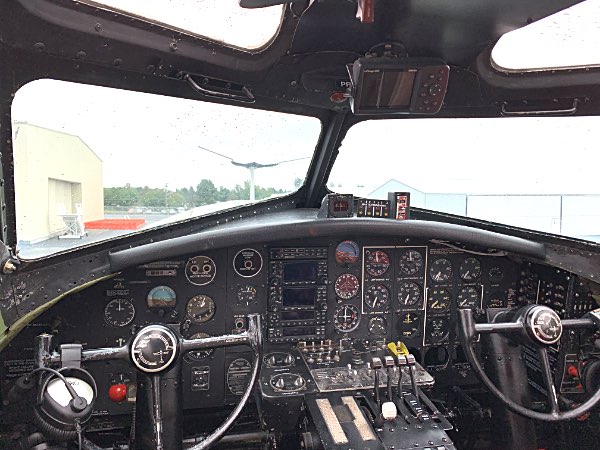 A view from the cockpit: some of the original flight instruments have been replaced with more modern ones that a working airplane in the present day needs
A view from the cockpit: some of the original flight instruments have been replaced with more modern ones that a working airplane in the present day needs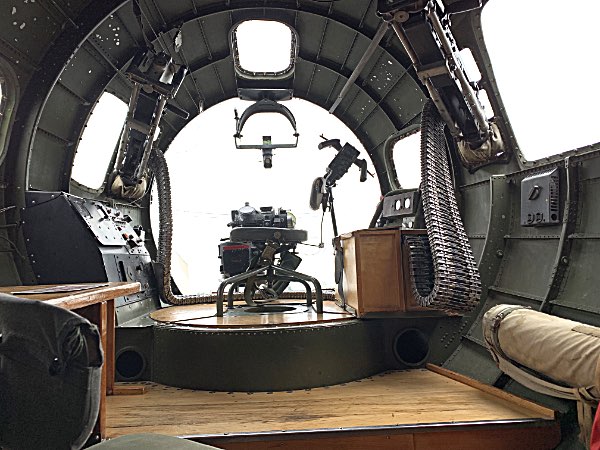 This gun position is in front of the cockpit where the pilots sit.
This gun position is in front of the cockpit where the pilots sit.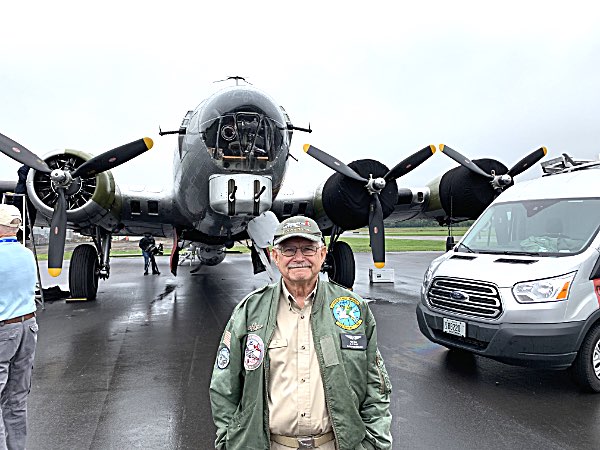 Rex Gray is one of two volunteer EAA pilots who are flying the B-17 in Ithaca this weekend
Rex Gray is one of two volunteer EAA pilots who are flying the B-17 in Ithaca this weekend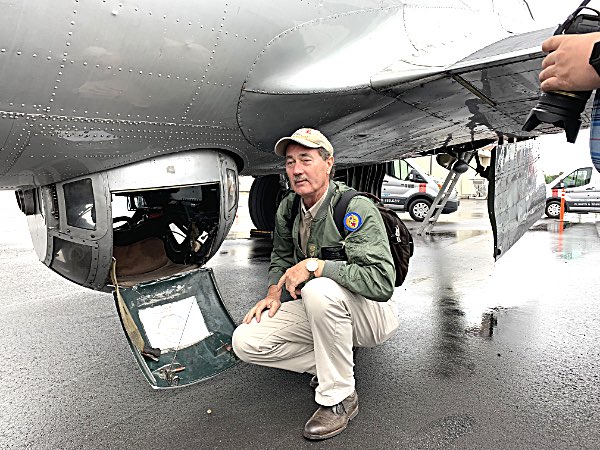 You had to be flexible and skinny to fit into the ball turret on the bottom of the B-17
You had to be flexible and skinny to fit into the ball turret on the bottom of the B-17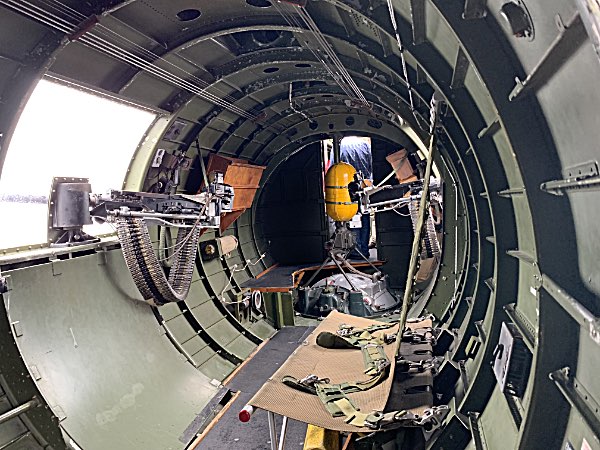 Gun positions on either side of the B-17
Gun positions on either side of the B-17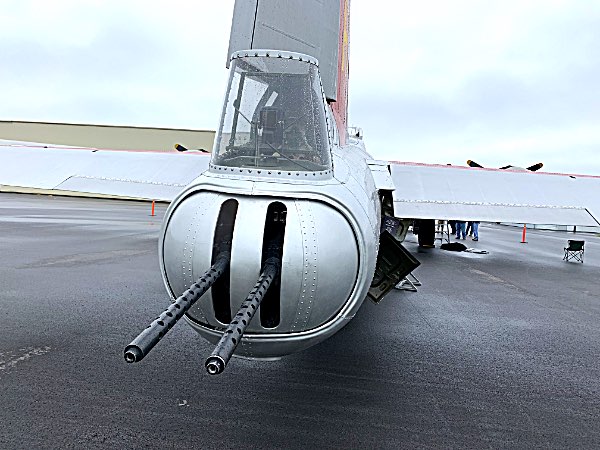 A view of gun positions at the rear of the B-17
A view of gun positions at the rear of the B-17According to Boeing, which manufactured B-17s, "The B-17 was a low-wing monoplane that combined aerodynamic features of the XB-15 giant bomber, still in the design stage, and the Model 247 transport. The B-17 was the first Boeing military aircraft with a flight deck instead of an open cockpit and was armed with bombs and five .30-caliber machine guns mounted in clear 'blisters'."
The B-17G-VE, nicknamed 'Aluminum Overcast', that is on view this weekend, was delivered to the U.S. Army Air Corps on May 18, 1945. It was too late to be used in World War II, so it was sold for $750 as surplus in the following year. In 1978 it was purchased by an aviation heritage group, 'B-17s Around the World', but the cost of renovating and maintaining the plane was too much. They donated the plane to the Experimental Aviation Association in 1983, and it was put on display in the EAA museum in Oshkosh, Wisconsin. After ten years of restoration it began touring in 1994. When it is no longer able to tour it will be housed in the EAA Museum's World War II aircraft exhibit.
While this particular B-17 was not used in the war, EAA restorers modeled its colors on the design of the 398th Bomb Group. That unit flew hundreds of missions over Nazi-held territory during World War II.
"World War II was a long and brutal war, and aerial bombardment played a big role in our ability to win in Europe," said Hall, a retired US Air Force Major General. "Most of the combatants were very young -- teenagers, young 20s. They did incredible things with aviation technology, which was, of course, very new at the time. You're talking two decades after 'Tommy'. If you saw 'Tommy' fly last year you know that was a pretty primitive machine. There was terrific advancement in just a couple of decades worth of time and, of course, all these people who had no tie to aviation -- they came off the farm and out of the cities. There were 40,000 training accidents each year in the early '40s. It's just mind boggling. But the product was crews that go in these airplanes. They had a 75% chance of finishing 25 missions -- that's not very good odds. But they did. And we won."
While you don't have to be at Airport Day to catch a flight or a tour of the B-17, it is just one of the attractions Saturday. Aside from the pancake breakfast, Airport Day will feature the Runway 5K run, antique cars, airport equipment, displays of various types of aircraft that are based in Ithaca or flying in, and Crossroad the Clown. As they do every year, East Hill Flying Club will also be offering 'Discovery Flights'.
The B-17 is scheduled to leave Monday. It's next stop is Glens Falls, New york.
v15i35



